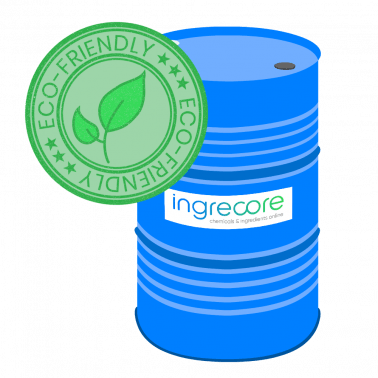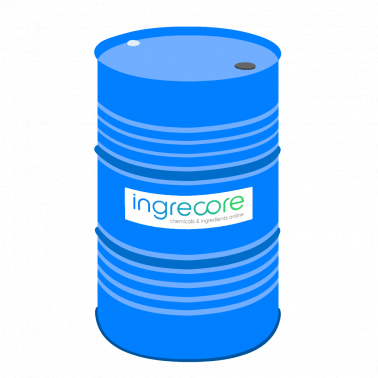Glycinate SL
Sodium Lauroyl GlycinateItem #: 2235
Best available price $2.93/kg
| QTY in KG | FOB price per KG |
|---|---|
| Kilogram | |
| 200 | $3.55 |
| 400 | $3.30 |
Benefits Glycinate SL
- Extemely mild surfactant that leaves a pleasant, silky skin feel
- High foaming
- Great biodegradability
- Creates a creamy and elastic foam
- Great choice for co-surfactant
- Wholesale quantities from a reliable supplier
Packaging Description
- Drums of 200 KG. One full pallet is 4 drums (800 KG). One 20 ft container is 20 pallets (16 MT)
- IBCs of 1000 KG. One 20 ft container of 20 IBC (20 MT).
Leadtime
Available for shipment within 2 weeksProduct information Glycinate SL
Description
Glycinate SL is an amino acid derived surfactant that is extremely mild. It's high foaming and creates a creamy and elastic foam that will leave a silky and very pleasant skin feel. When used as a co-surfactant it reduces irritancy and boosts foam properties of the formulation. It can be used in a wide range of personal care applications from skin and body care to hair care and oral care. Glycinate SL is based on the natural amino acid Glycine, and it is biodegradable.
INCI Name
Sodium Lauroyl Glycinate
Chemical Name
Glycine, N-coco acyl derivs., sodium salts
HS Code
3402.3990
CAS Number
18777-32-7
Product Form
Liquid
Region of Origin
Asia Pacific
Reach
01-2120025120-81-XXXX
Product Group
Amino Acid-based Surfactants
Product Group Description
The consumer demand for greener, safer, and milder ingredients has changed many formulations in the last decades. In the ingredient group of surfactants, a clear shift away from products such as Sodium Lauryl Sulfate (SLS) and SLES to sulfate free surfactants is taking place. This is based on the perception that ether sulfates are potentially toxic or carcinogenic; especially Sodium Lauryl Sulfate has a bad reputation. An interesting and growing, sulfate-free, and extremely mild surfactant family is the group of amino acid-based surfactants. Amino acids are used as polar head group for surfactants and can be combined with fatty acids to produce a wide variety of amino acid-based surfactants, including amphoteric surfactants, cationic surfactants, nonionic surfactant, however mainly anionic surfactants.
Relevant for many industries, amino acid surfactants have the perfect characteristics for use in personal care and cleaning applications. This group of anionic surfactants has good biodegradability and biocompatibility and is known for its outstanding mildness and foaming properties. Their good foaming properties are normally not impacted by alkaline environment and therefore can be used in high pH applications. They have good cleansing properties and give hair and skin a long-lasting soft feeling. As a co-surfactant amino acid-based surfactants can help to reduce the irritating effects of other surfactants. The outstanding mildness make it perfect ingredients for baby care, sensitive skin, and facial care products. Generally suitable for body and hair care rinse off and cleansing agent products. Rinsing off most amino acid-based surfactants is very fast and easy compared to other surfactant systems and will contribute to reducing water consumption. The following groups of amino acid-based surfactants are often used in personal care and cleaning applications:
Glutamates are based on the naturally occurring amino acid called L-glutamic acid. Most used INCI names in this group of glutamates are Disodium Cocoyl Glutamate (examples are Glutamate DC30, Glutamate DC40, Glutamate DC100 or Glutamate SL100) Disodium Lauroyl Glutamate, Sodium Lauroyl Glutamate, Sodium Myristoyl Glutamate, Potassium Cocoyl Glutamate, and Potassium Myristoyl Glutamate.
Glycinates are from the amino acid glycine, which is a main component of coconut fatty acid and human skin collagen. Most used INCI names of products in this group are Potassium Cocoyl Glycinate, Sodium Cocoyl Glycinate, and Sodium Lauroyl Glycinate.
Sarcosinates are surfactants based on amino acid Sarcosine (N-Methyl Glycine). The most well-known product in cosmetics in this group is Sodium Lauroyl Sarcosinate. What is Sodium Lauroyl Sarcosinate? It has all the properties of amino acid derived anionic surfactants: biodegradable, hard and salt water tolerant, strong foam producer, extremely mild and reduces irritation due to other surfactants. Sodium Lauroyl Sarcosinate in skin care is used in cleansers for face, body and hands and formulated in many bath and shower products. Sodium Lauroyl Sarcosinate for hair is mainly used in shampoos and as hair conditioning agent.
Alaninates are surfactants derived from the amino acid Alanine. Alaninate SC30-5 has INCI name Sodium Cocoyl Alaninate and is based on L-alanine and coconut oil fatty acid natural ingredients.
Relevant for many industries, amino acid surfactants have the perfect characteristics for use in personal care and cleaning applications. This group of anionic surfactants has good biodegradability and biocompatibility and is known for its outstanding mildness and foaming properties. Their good foaming properties are normally not impacted by alkaline environment and therefore can be used in high pH applications. They have good cleansing properties and give hair and skin a long-lasting soft feeling. As a co-surfactant amino acid-based surfactants can help to reduce the irritating effects of other surfactants. The outstanding mildness make it perfect ingredients for baby care, sensitive skin, and facial care products. Generally suitable for body and hair care rinse off and cleansing agent products. Rinsing off most amino acid-based surfactants is very fast and easy compared to other surfactant systems and will contribute to reducing water consumption. The following groups of amino acid-based surfactants are often used in personal care and cleaning applications:
Glutamates are based on the naturally occurring amino acid called L-glutamic acid. Most used INCI names in this group of glutamates are Disodium Cocoyl Glutamate (examples are Glutamate DC30, Glutamate DC40, Glutamate DC100 or Glutamate SL100) Disodium Lauroyl Glutamate, Sodium Lauroyl Glutamate, Sodium Myristoyl Glutamate, Potassium Cocoyl Glutamate, and Potassium Myristoyl Glutamate.
Glycinates are from the amino acid glycine, which is a main component of coconut fatty acid and human skin collagen. Most used INCI names of products in this group are Potassium Cocoyl Glycinate, Sodium Cocoyl Glycinate, and Sodium Lauroyl Glycinate.
Sarcosinates are surfactants based on amino acid Sarcosine (N-Methyl Glycine). The most well-known product in cosmetics in this group is Sodium Lauroyl Sarcosinate. What is Sodium Lauroyl Sarcosinate? It has all the properties of amino acid derived anionic surfactants: biodegradable, hard and salt water tolerant, strong foam producer, extremely mild and reduces irritation due to other surfactants. Sodium Lauroyl Sarcosinate in skin care is used in cleansers for face, body and hands and formulated in many bath and shower products. Sodium Lauroyl Sarcosinate for hair is mainly used in shampoos and as hair conditioning agent.
Alaninates are surfactants derived from the amino acid Alanine. Alaninate SC30-5 has INCI name Sodium Cocoyl Alaninate and is based on L-alanine and coconut oil fatty acid natural ingredients.
Markets, applications & functions Glycinate SL
Product Functions
Anionic Surfactant, Cleansing, Foaming agent
Similar or equivalent to
ROKatend GL; Pureact SLG; Eversoft YLS
Applications
Body Lotions, Body Washes, Facial Masks, Skin Moisturizers, Mouth Washes, Shampoos, Shower Gels, Skin Exfoliators, Soaps, Toothpaste
SubMarket
Body Care, Hair Care, Oral Care, Skin Care
Market
Personal Care
Product Hazard information
CLP-GHS pictograms





